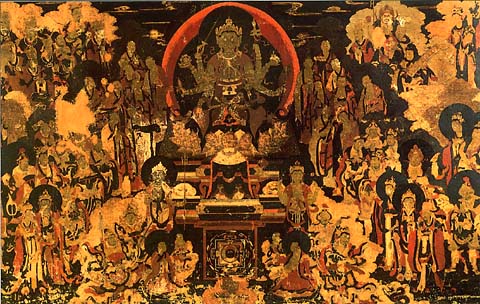
Mahamayuri Preaching
Ming Dynasty
South Wall, Dabaoji Palace, Baisha

|
Mahamayuri PreachingMing Dynasty South Wall, Dabaoji Palace, Baisha |
Although numerous paintings on paper and silk remain to us from the Ming dynasty, it is rare to encounter surviving wall-paintings from that period. The frescoes in Baisha township are distributed among several buildings; the examples selected here are all from Dabaoji Palace. Religiously and artistically, they are somewhat eclectic, and represent a mix of Esoteric and Tibetan Buddhism with some mainstream Mahayana and Daoist material. In this way the frescoes reflect many of the cultural influences that have operated on the Naxi people and other inhabitants of this part of Yunnan. This region (surrounding Lijiang) lies high on the plateau and close to Tibet, and has consequently absorbed many Tibetan religious practices.
In Dabaoji Palace, the main scene on each wall is a deity preaching: Amida on the front wall, Avalokiteshvara on the north, Guru Rinpoche (Padmasambhava, the founder of Tibetan Buddhism) on the west, and the lesser-known Mahamayuri (see below) on the south. On each wall, the central deity is surrounded in turn by attendant deities, Bodhisattvas, and other figures, all of whom are listening to, and in some cases (Avalokiteshvara) enacting, the particular sutra that the central deity is preaching.
The central part of the scene of Mahamayuri, from the south wall, is shown here by way of example. This goddess (sic) is an Esoteric Wisdom King, one of the pantheon of vidyarajas (Buddhist protectors) like Acala, Yamantaka, etc. Here the multi-armed goddess, enthroned and enclosed in a mandorla-like frame, preaches her sutra to a crowded audience of deities, other celestials, monks, and officials. A mandala hangs at the base of her throne.
The murals are somewhat damaged, but it is easy to make out their overall composition, and to imagine how spectacular they would have appeared when freshly painted and gilded, Black areas were once brightly colored, but have oxidized over time.

|

|